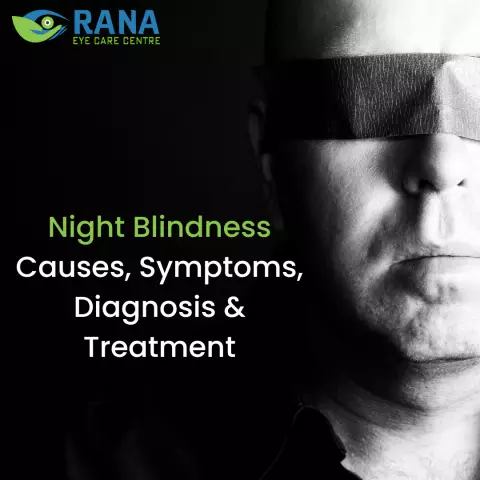- Author Rachel Wainwright [email protected].
- Public 2023-12-15 07:39.
- Last modified 2025-11-02 20:14.
Color blindness

Color blindness is a violation of the color perception of the eye. On the retina of the eye, in the central region called the macula or macula, are the cells responsible for the perception and transmission of color. Such cells are called cones. There are three types of cones, each containing one of three types of pigment - blue, red, and yellow. These are the primary colors that the eye perceives, and the rest of the variety of colors and shades is formed by mixing blue, red and yellow. Lack or absence of one of the pigments causes color impairment. In most cases, violations are associated with a lack of red pigment, much less often - blue. Color blindness is not an independent disease, it is either a congenital anomaly or a symptom of other eye diseases or some common diseases.
The history of the discovery of color blindness and interesting facts related to it
This condition was first described by the English chemist John Dalton in 1794. Since hereditary color blindness is manifested in children from birth, they are often unaware that their perception of colors is different from that of other people. John Dalton had no idea about this, until one day he ordered himself an elegant gray jacket for a dinner party. When he came to the celebration in it, it suddenly turned out that other people see his jacket not gray, but bright burgundy.
John Dalton, like his brothers, suffered from a violation of the perception of red, which he later described in detail, giving the name to the new ophthalmological syndrome. In fact, the word "suffered" in this case should not be taken literally, since people with congenital color blindness usually do not experience any inconvenience associated with their peculiarity, since from birth they see the world differently, and do not have the opportunity to compare their vision with someone else.
Color blindness does not prevent a person from perceiving the world in its beauty and diversity, and does not make him incapable of creativity. The most famous example is the canvases of Mikhail Vrubel. Based on the gray scale of his works, researchers of Vrubel's work assumed that the artist was a pessimist, prone to depression. However, later it turned out that the artist simply did not perceive some colors, being color blind. Nevertheless, this fact did not prevent him from being a brilliant painter who left a bright mark on the history of culture.
Causes of color blindness
Color blindness can be congenital and acquired. The most common cases of congenital color blindness, transmitted as a genetic abnormality associated with the female sex chromosome, and inherited from mother to son. In this case, color blindness manifests itself in children immediately, from the first years of life, although the condition is not always immediately detected by others. Color blindness in women is much less common than in men, women are involved in the transfer of a recessive gene, but they themselves, as a rule, do not have this defect. However, acquired color blindness in women occurs with the same frequency as in men.

Acquired color blindness occurs as a result of damage to the retina in the macular region and diseases of the optic nerve, in which the color rendition is distorted even under the condition of its normal perception by cones. Also, color blindness can be a sign of cataracts or diseases of the central nervous system, including brain damage.
Signs of color blindness
The main and only sign of color blindness is a violation of color perception. Being a deviation of vision, color blindness, however, does not affect either its acuity or any other characteristics. As mentioned above, color blindness in children may not attract attention for a long time, since children take their color perception for granted, and call the grass green, even if they see this color differently. As a rule, parents notice color blindness in children when it is discovered that the child does not see the difference between, for example, gray and red, or gray and green.
Normal vision is characterized by trichromacy (from "chromos" - color), when the cones perceive red, blue and yellow colors equally well. When one of the pigments completely disappears from the process, they talk about dichromacy, in the absence of all pigments, about achromacy, in this case a person perceives the world as colored in various shades of gray. However, dichromacy, and even more so, achromacy are extremely rare and usually in this case there are other serious visual impairments, color blindness is only one of them. Most often they talk about abnormal trichromacy, when the function of one of the pigments is not completely lost, but reduced.
Diagnosis of color blindness
Violation of color perception is diagnosed using special polychromatic tables, the so-called Rabkin tables, which are used when conducting a color blindness test. They are drawings made with dots or circles of the same brightness, but differing in color. With usually preserved visual acuity, color blindness affects only the perception of color, that is, noticing the degree of brightness, color blind people do not notice the color. Therefore, on some tables, they do not distinguish the figure, perceiving the table as a field evenly filled with circles or dots.
Sometimes, if there are cases of color blindness in the family, a woman, planning to conceive, wants to find out the possibility of color blindness in children. In this case, a genetic test for color blindness is performed, which includes diagnostics by studying family history, as well as DNA testing. A genetic test for DNA color blindness is a highly accurate study that allows you to determine the gene in which the mutation has occurred and its nature. Unfortunately, the ability to correct the breakdown, even when finding out the exact cause of the gene defect, is currently impossible, and such information has no practical application, and the research itself is very expensive.
Color blindness treatment

At the moment, there is no effective treatment for color blindness. Attempts are being made to correct color perception disturbances using special lenses coated with a special layer, the composition of which allows the wavelength to be changed when certain colors are perceived. However, until now these attempts have not been very successful, and no significant improvement has been observed with the use of such means.
Since congenital color blindness does not progress, a person simply learns to correct perception, taking into account his own characteristics, for example, remembering that the upper color in a traffic light is red, and the lower one is green. Acquired color blindness requires, first of all, the treatment of the underlying disease that caused the appearance of such a symptom.
YouTube video related to the article:
The information is generalized and provided for informational purposes only. At the first sign of illness, see your doctor. Self-medication is hazardous to health!






